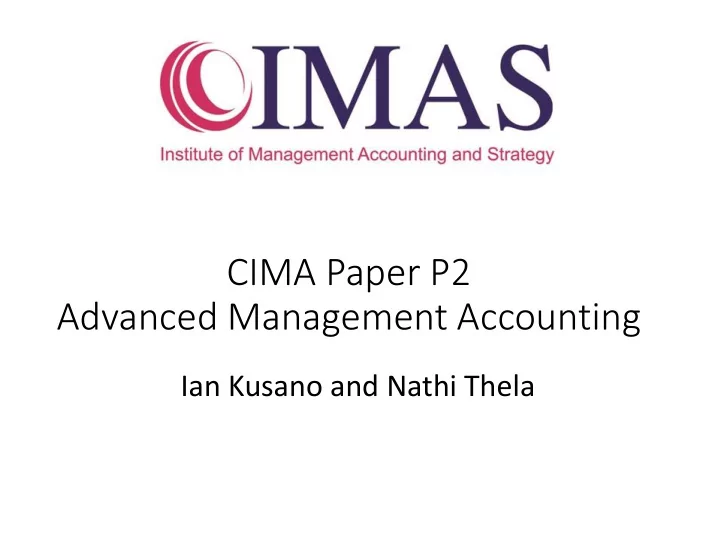

CIMA Paper P2 Advanced Management Accounting Ian Kusano and Nathi Thela
Session Learning Curves 1
Learning Outcome Lead A1: Evaluate techniques for analysing and managing costs for competitive advantage Component A1d): Apply learning curves to estimate time and cost for activities, products and services • Learning curves and their use in predicting product/service costs, including derivation of the learning rate and the learning index. 2
Learning Curve • It has been observed in some industries that there is a tendency for labour time per unit to reduce in time • as more of the units are produced , workers become more familiar with the task. • The first time a new operation is performed, both the workers and the operating procedures are untried. As the operation is repeated, the workers become more familiar with the work, labour efficiency increases and the labour cost per unit declines. • Wright's Law states that as cumulative output doubles, the cumulative average time per unit falls to a fixed percentage (the 'learning rate') of the previous average time. 3
Session Content Learning Curves The Formula Applications The Table 4
Learning Curve As cumulative output doubles, the cumulative average time per unit falls to a given percentage of the previous cumulative average time per unit. 5
Learning Curve A new product will take 100 hours for the first unit. An 80% learning curve applies Cumulative Incremental Average Total Total Average Units Units time p.u. time time time p.u. 1 100 100 6
Learning Curve A new product will take 100 hours for the first unit. An 80% learning curve applies Cumulative Incremental Average Total Total Average Units Units time p.u. time time time p.u. 1 100 100 1 100 100 2 80 160 1 60 60 4 64 256 2 96 48 8 51.2 409.6 4 153.6 38.4 16 40.96 655.36 8 245.76 30.72 7
Learning Curve Formula Hours for 1 st unit Cumulative no. of units Average hours y = a x b per unit Log learning rate Log 2 8
Learning Curve – Exercise 1 The first unit of a new product is expected to take 100 hours. An 80% learning curve is known to apply. Calculate: (a) the average time per unit for the first 16 units; (b) the average time per unit for the first 25 units; (c) the time it takes to make the 20th unit. 9
Learning Curve – Exercise 2 A firm produces 100 units and the average time per unit is 5.32 hours. A 90% learning curve applies. Required: a) Find the average time per unit if 500 units are produced. b) Find the average time per unit for the next 250 units. 10
Applications of the Learning Curve Effect The Steady State • Eventually, the learning effect will cease and the time to make each successive unit stabilises at a constant time per unit. This is because there is a limit to manual dexterity and/or other limiting factors come into play such as a limit on how quickly materials can be supplied. Application of the Learning Curve Effect • Pricing decision • Work scheduling • Standard setting & Budgeting 11
Experience Curve Are very similar to learning curves but they cover all costs, not just labour costs. 1.Material costs may decrease slightly with quantity discounts, etc. but will not decrease by a large amount. 2.Variable overheads often follow the pattern of direct labour and so may decrease in a similar way 3.Fixed overheads will decrease per unit as more units are made. 12
Recommend
More recommend